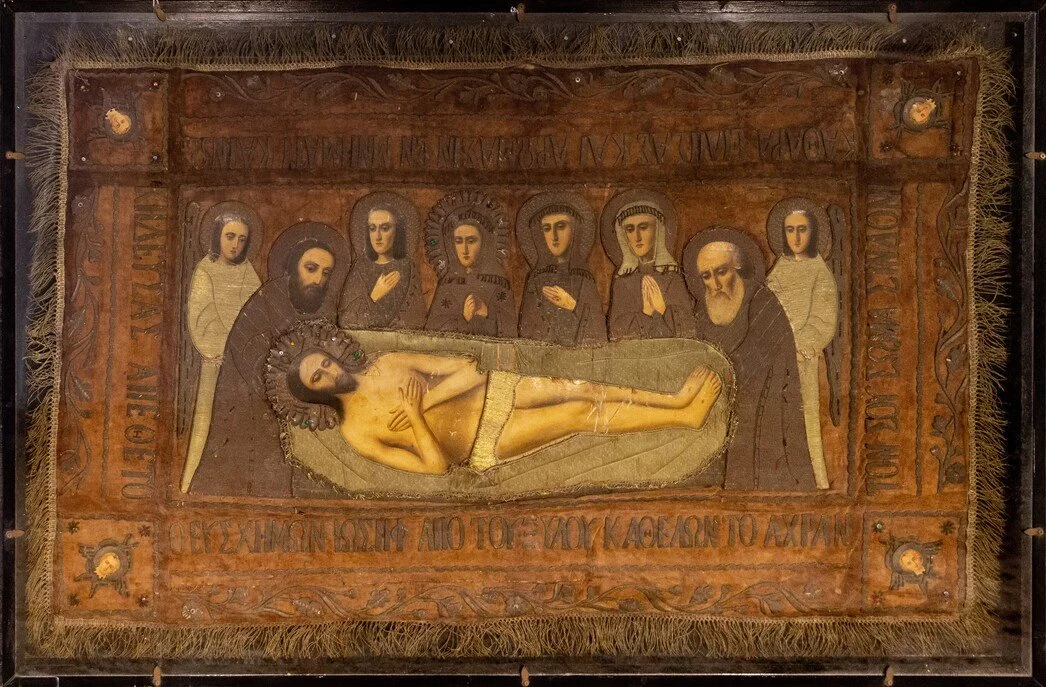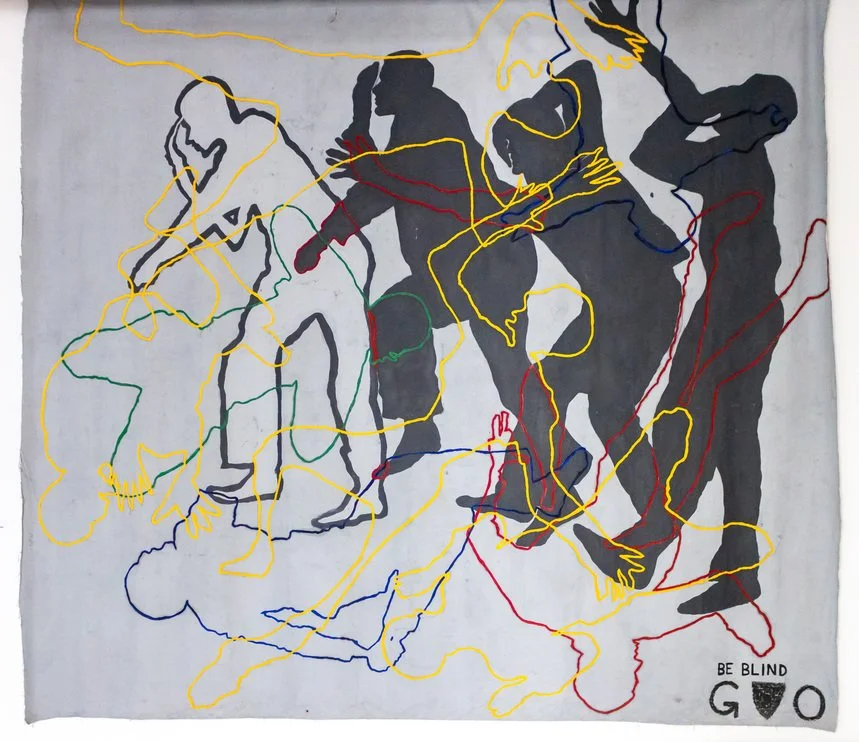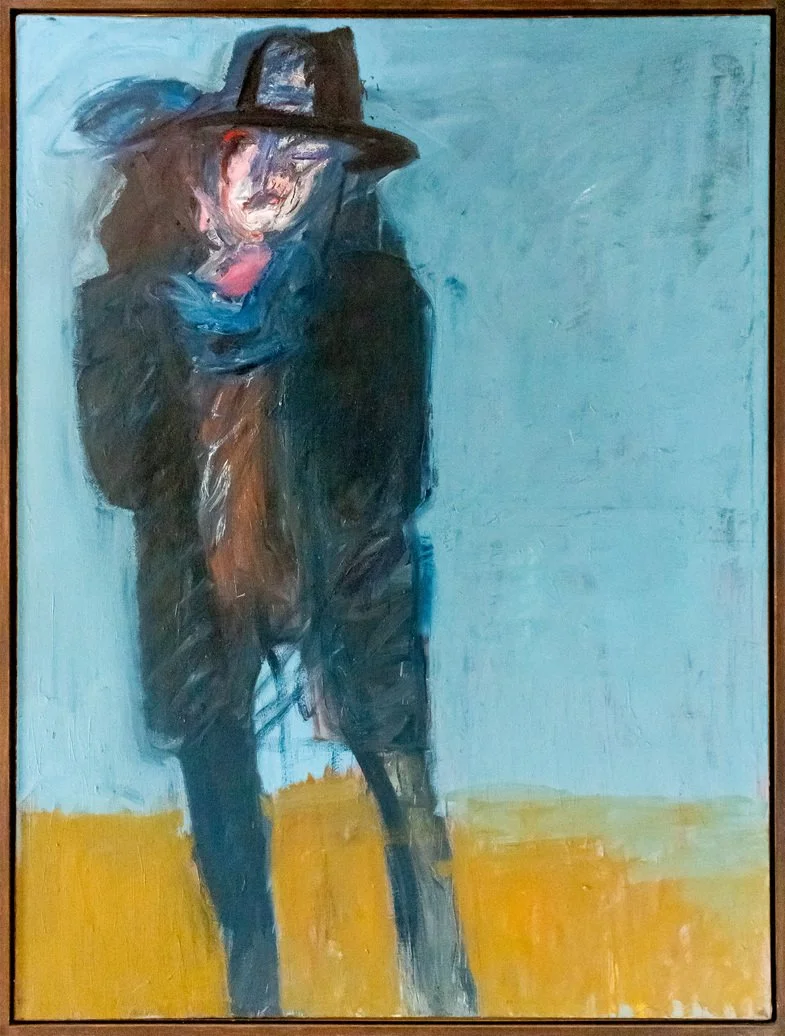01.13 A 'Plashinitza'
English
An Easter processional banner of the Greek Orthodox Church, by an unknown artist, using elaborately worked velvet, dating from the 19th century. Framed and glazed. 70 cm high by 118cm wide.
The banner depicts the oft-painted scene in the tomb to which Joseph of Arimethia took the body of Jesus after the crucifixion. It is made from oak-brown velvet, elaborately worked in couched metal threads and coloured paste. The areas of skin are of appliqué, gessoed and painted canvas. We bought it at auction at Christies in South Kensington (Sale 9254, lot 230, in November 2001). The surround which is inscribed in Greek with metal thread lettering, says:- Ο ΕΥΣΧΗΜΩΝ ΙΩΣΗΦ ΑΠΌ ΤΌΥΞΥΛΟΥ ΚΑΘΕΛΩΝ ΤΟ ΑΧΡΑΝ ΤΟΝ ΣΟΥ ΣΩΜΑ ΣΙΝΔΟΝΙ ΚΑΘΑΡΑ.ΕΙΛΗΣΑΣ ΚΑΙ ΑΡΩΜΑΣΙΝ ΕΝ ΜΝΗΜΑΤΙ ΚΑΙΝΟ.ΚΗΔΕΥΣΑΣ ΑΠΕΘΕΤΟ It’s a long time since I studied Greek at school, but I think this translates as:- THE BLESSED JOSEPH OF TOUXYLOU (ARIMETHEA??) CAREFULLY WRAPS HIS BODY IN A CLEAN SHROUD. ESSENCES AND AROMAS ADD TO THE MEMORIAL. A PROPER FUNERAL There is an identical piece in the Church of Agios Sostis (Christ the Saviour) at Parga in north west Greece, still used in their Easter epitaphios procession.
Spanish
Una ‘Plashinitza’
Un estandarte procesional de Pascua de la Iglesia Ortodoxa Griega, de un artista desconocido, utilizando terciopelo elaborado, que data del siglo XIX. Enmarcado y acristalado. Mide 70 cm de alto por 118 cm de ancho.
El estandarte representa la escena pintada a menudo en la tumba, a la que José de Arimatea llevó el cuerpo de Jesús después de la crucifixión. Está hecho de terciopelo marrón roble, trabajado de forma elaborada con hilos de metal revestido y pasta de colores. Las zonas de piel son de aplique, gesso y lienzo pintado. Lo compramos en una subasta en Christies en South Kensington (Venta 9254, lote 230, noviembre de 2001). El marco, que está inscrito en griego con letras de hilo de metal, dice:
Ο ΕΥΣΧΗΜΩΝ ΙΩΣΗΦ ΑΠΌ ΤΌΥΞΥΛΟΥ ΚΑΘΕΛΩΝ ΤΟ ΑΧΡΑΝ ΤΟΝ ΣΟΥ ΣΩΜΑ ΣΙΝΔΟΝΙ ΚΑΘΑΡΑ.ΕΙΛΗΣΑΣ ΚΑΙ ΑΡΩΜΑΣΙΝ ΕΝ ΜΝΗΜΑΤΙ ΚΑΙΝΟ.ΚΗΔΕΥΣΑΣ ΑΠΕΘΕΤΟ
Hace mucho tiempo que no estudié griego en la escuela, pero Creo que esto se traduce como: EL BENDITO JOSÉ DE ARIMATEA ENVUELVE CUIDADOSAMENTE SU CUERPO EN UNA SÁBANA LIMPIA. ESENCIAS Y AROMAS SE SUMAN AL MEMORIAL. UN FUNERAL APROPIADO. Hay una pieza idéntica en la Iglesia de Agios Sostis (Cristo el Salvador) en Parga, en el noroeste de Grecia, que todavía se usa en su procesión de epitafios de Pascua.





